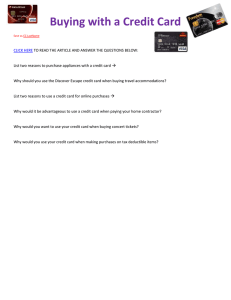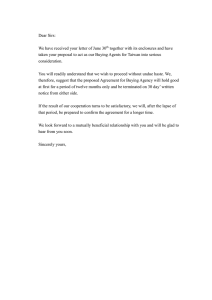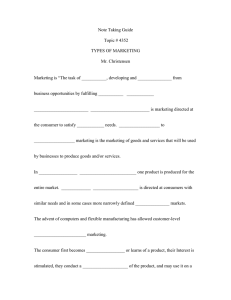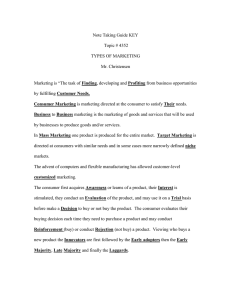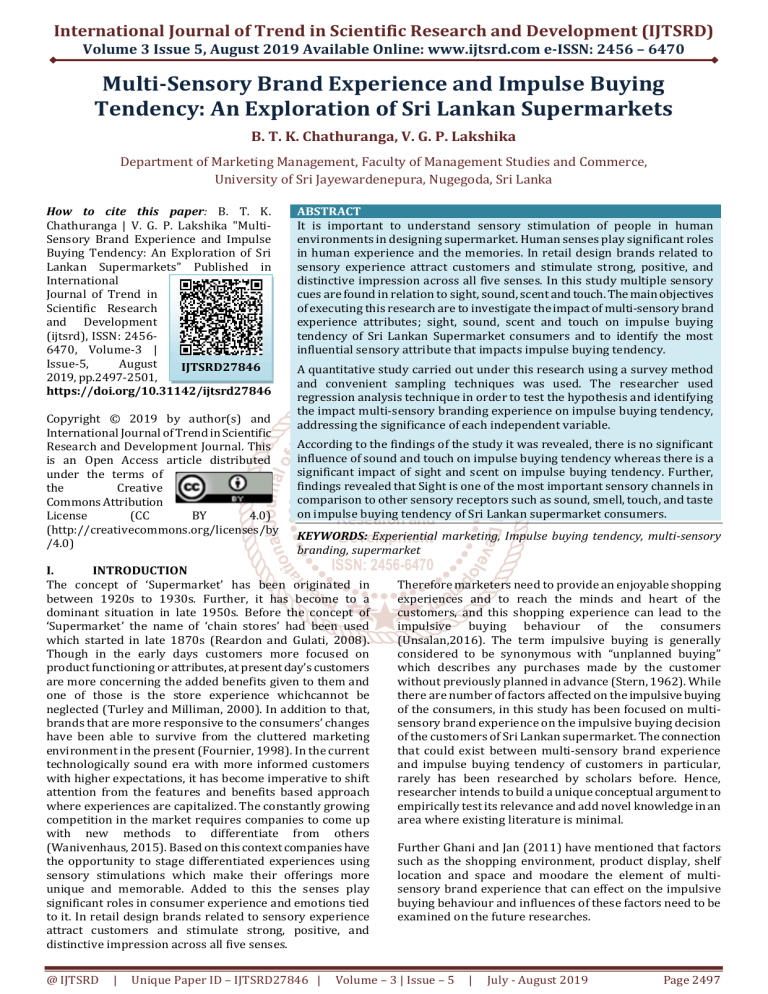
International Journal of Trend in Scientific Research and Development (IJTSRD)
Volume 3 Issue 5, August 2019 Available Online: www.ijtsrd.com e-ISSN: 2456 – 6470
Multi-Sensory Brand Experience and Impulse Buying
Tendency: An Exploration of Sri Lankan Supermarkets
B. T. K. Chathuranga, V. G. P. Lakshika
Department of Marketing Management, Faculty of Management Studies and Commerce,
University of Sri Jayewardenepura, Nugegoda, Sri Lanka
How to cite this paper: B. T. K.
Chathuranga | V. G. P. Lakshika "MultiSensory Brand Experience and Impulse
Buying Tendency: An Exploration of Sri
Lankan Supermarkets" Published in
International
Journal of Trend in
Scientific Research
and Development
(ijtsrd), ISSN: 24566470, Volume-3 |
Issue-5,
August
IJTSRD27846
2019, pp.2497-2501,
https://doi.org/10.31142/ijtsrd27846
Copyright © 2019 by author(s) and
International Journal of Trend in Scientific
Research and Development Journal. This
is an Open Access article distributed
under the terms of
the
Creative
Commons Attribution
License
(CC
BY
4.0)
(http://creativecommons.org/licenses/by
/4.0)
ABSTRACT
It is important to understand sensory stimulation of people in human
environments in designing supermarket. Human senses play significant roles
in human experience and the memories. In retail design brands related to
sensory experience attract customers and stimulate strong, positive, and
distinctive impression across all five senses. In this study multiple sensory
cues are found in relation to sight, sound, scent and touch. The main objectives
of executing this research are to investigate the impact of multi-sensory brand
experience attributes; sight, sound, scent and touch on impulse buying
tendency of Sri Lankan Supermarket consumers and to identify the most
influential sensory attribute that impacts impulse buying tendency.
A quantitative study carried out under this research using a survey method
and convenient sampling techniques was used. The researcher used
regression analysis technique in order to test the hypothesis and identifying
the impact multi-sensory branding experience on impulse buying tendency,
addressing the significance of each independent variable.
According to the findings of the study it was revealed, there is no significant
influence of sound and touch on impulse buying tendency whereas there is a
significant impact of sight and scent on impulse buying tendency. Further,
findings revealed that Sight is one of the most important sensory channels in
comparison to other sensory receptors such as sound, smell, touch, and taste
on impulse buying tendency of Sri Lankan supermarket consumers.
KEYWORDS: Experiential marketing, Impulse buying tendency, multi-sensory
branding, supermarket
I.
INTRODUCTION
The concept of ‘Supermarket’ has been originated in
between 1920s to 1930s. Further, it has become to a
dominant situation in late 1950s. Before the concept of
‘Supermarket’ the name of ‘chain stores’ had been used
which started in late 1870s (Reardon and Gulati, 2008).
Though in the early days customers more focused on
product functioning or attributes, at present day’s customers
are more concerning the added benefits given to them and
one of those is the store experience whichcannot be
neglected (Turley and Milliman, 2000). In addition to that,
brands that are more responsive to the consumers’ changes
have been able to survive from the cluttered marketing
environment in the present (Fournier, 1998). In the current
technologically sound era with more informed customers
with higher expectations, it has become imperative to shift
attention from the features and benefits based approach
where experiences are capitalized. The constantly growing
competition in the market requires companies to come up
with new methods to differentiate from others
(Wanivenhaus, 2015). Based on this context companies have
the opportunity to stage differentiated experiences using
sensory stimulations which make their offerings more
unique and memorable. Added to this the senses play
significant roles in consumer experience and emotions tied
to it. In retail design brands related to sensory experience
attract customers and stimulate strong, positive, and
distinctive impression across all five senses.
@ IJTSRD
|
Unique Paper ID – IJTSRD27846 |
Therefore marketers need to provide an enjoyable shopping
experiences and to reach the minds and heart of the
customers, and this shopping experience can lead to the
impulsive buying behaviour of the consumers
(Unsalan,2016). The term impulsive buying is generally
considered to be synonymous with “unplanned buying”
which describes any purchases made by the customer
without previously planned in advance (Stern, 1962). While
there are number of factors affected on the impulsive buying
of the consumers, in this study has been focused on multisensory brand experience on the impulsive buying decision
of the customers of Sri Lankan supermarket. The connection
that could exist between multi-sensory brand experience
and impulse buying tendency of customers in particular,
rarely has been researched by scholars before. Hence,
researcher intends to build a unique conceptual argument to
empirically test its relevance and add novel knowledge in an
area where existing literature is minimal.
Further Ghani and Jan (2011) have mentioned that factors
such as the shopping environment, product display, shelf
location and space and moodare the element of multisensory brand experience that can effect on the impulsive
buying behaviour and influences of these factors need to be
examined on the future researches.
Volume – 3 | Issue – 5
|
July - August 2019
Page 2497
International Journal of Trend in Scientific Research and Development (IJTSRD) @ www.ijtsrd.com eISSN: 2456-6470
II.
LITERATURE REVIEW
“In branding literature, the concept of brand identity is
defined as a unique set of brand associations that a firm can
create or maintain” (Aaker, 2014). In other words, it is the
impression or the unique space the brand intends to occupy
in the consumer’s mind. It may involve a value-proposition
with functional, emotional or self-expressive benefits. The
emotional linkage between a brand and a consumer is
important in building strong brands. Researchers also
confirms that consumers look for and buy emotional
experiences around what has been bought and no longer
buys products and services alone (Brembeck and Ekstro,
2004).Hence, the modern marketing practitioners have
realized the need to go beyond conventional methods of
creating brand identity. With that arena sensory elements
are increasingly becoming important when conceptualizing a
revised corporate identity construct (Bartholmé and
Melewar, 2011).Furthermore, it is essential to move
attention from the features-and-benefits approach
advocated by traditional marketing to given that customers
with experiences. In contrast to its narrow focus on
functional features and benefits in traditional marketing,
experiential marketing focuses on customer experiences.
Experiences occur as a result of encountering, undergoing or
living through things. Experiences provide sensory,
emotional, cognitive, behavioural, and relational values that
replace functional values (Schmitt, 2014).
A. Sensory Branding
Sensory branding is based on the phenomenon that human
beings most likely to form, retain and revisit memory when
all five senses (taste, smell, sight, sound and touch) are
engaged (Hussain, 2017). Sensory branding uses these
human instincts as a strategy to sell their goods or services
by creating such environment that appeals to senses at the
point of sale.
B. Multi-Sensory Branding
“A multi-sensory brand-experience takes place when more
than one of the five senses contributes to the perception of
sensory experiences” (Hulten, 2011). The multi-sensory
brand experience is defined as a brand-experience that
supports individual value creation and refers to how
individuals respond when a firm interacts, and supports
their purchase and consumption processes through the
involvement of the five senses in generating customer value,
experiences, and brand as image (Hultén, 2011).
Building on Bitner’s (1992) categorization of the three
environmental dimensions of retail atmosphere which are;
ambient conditions; space/ function; and signs, symbols and
artefacts, and drawing on Kotler’s (1973) categorization of
store atmosphere (visual, aural, olfactory and tactile), Soars
(2009) categorized retail atmosphere according to the four
senses of sight, sounds, smell and touch.
C. Impulsive Buying Behaviour
Impulse buying behaviour is a sudden, persuasive,
hedonically complex buying behaviour in which the rapidity
of an impulse decision process precludes thoughtful and
deliberate consideration of alternative information and
choices (Park, Kim and Forney, 2011). Given the focus on
experiential aspects of consumption, it seems vital that
marketers understand impulse buying behaviour at
supermarket from an experiential perspective. Further
@ IJTSRD
|
Unique Paper ID – IJTSRD27846 |
sensory branding strategy aims to generate positive
emotional state in the minds of the consumers and thereby
influence impulse buying tendency.
Hence following research main questions and sub research
questions were developed for the study:
1. Is there an impact of sight on impulse buying tendency
in supermarket?
2. Is there an impact of sound on impulse buying tendency
in supermarket?
3. Is there an impact of scent on impulse buying tendency
in supermarket?
4. Is there an impact of touch on impulse buying tendency
in supermarket?
5. What is the most influencing sensory branding
element/elements that stimulate/stimulates impulse
buying tendency in supermarket?
With the intention of coming with answers for the research
questions developed under the study the following
objectives were established.
1. To examine the impact of sight on impulse buying
tendency in supermarket.
2. To examine the impact of sound on impulse buying
tendency in supermarket.
3. To examine the impact of scent on impulse buying
tendency in supermarket.
4. To examine the impact of touch on impulse buying
tendency in supermarket.
5. To examine the most influencing sensory branding
element/ elements that stimulates/stimulate impulse
buying tendency.
D. Multi-sensory brand experience and Impulsive
Buying Behaviour
It is evident that the types of senses that build a multisensory brand experience have been categorized as
attributes of store atmosphere by well reputed researchers.
Namely they are sight, sound, scent and touch. Taste is not
given prominence by researcher in this context as it is less
applicable pertaining to the multi-sensory experience
created within Supermarket. Further it is emphasized that
the stimulating positive sensorial emotional states and
providing customer with a favourable shopping experiences
within the store has a high possibility on resulting in impulse
buying. There for it is rational to build following hypothesis.
Music is about complex set of expressive sound collection
since it consists with some key elements like rhythm, pitch,
melody and harmony. According to preview studies music
not only stimulate impulse buying independently but also
interact with other factors to affect impulsive buying
behaviour (Demoulin, 2011). Background music
coordinating with other factors, has such effects like
reducing consumers’ time perception of purchase and
waiting (Gelinas-chebat and Filiatrault, 1993) affecting
consumers’ perception of the entire environment (Hui, Dube
and Chebat, 1997) Increasing sales (Morrison et al., 2011)
influencing consumers’ impulsive buying tendency
(Morrison et al., 2011) changing consumers’ experiencing
attitude (Morrison et al., 2011) and promoting consumers’
interaction with the environment (Morrison et al., 2011).
Considering about the above facts background music is able
to influence consumers’ perception and stimulate
consumers’ positive emotion, so that consumers can enjoy
Volume – 3 | Issue – 5
|
July - August 2019
Page 2498
International Journal of Trend in Scientific Research and Development (IJTSRD) @ www.ijtsrd.com eISSN: 2456-6470
the shopping experience and be more likely to have
impulsive buying behaviour. Hence the first hypothesis aims
to discover whether music has a significant impact on
impulsive buying tendency
H1 : Music has a significant impact on impulsive buying
tendency.
As well as music, the smell of the store can also directly
influence on the emotions and moods of the consumers
(Levy and Weitz, 2002). Further, the pleasant environment
in the store makes customers to spend more time looking
through merchandise, which will result in impulse buying.
Moreover, how the store smell impacts on the impulse
buying behaviour has been identified by Matilla and Wirtz
(2008) and Mohan (2013) in their studies. Hence the next
hypothesis of this study is that
H2 : Smell has a significant impact on impulsive buying
tendency.
Retailers use window displays in the façade of the store to
attract customers into the store and provide message about
the products offered inside the store (Levy and Weitz, 2002).
As cited in Levy and Weitz (2002), Cornelius (2010)
mentions that well designed storefront window displays are
regarded as useful technique to attract the attention of new
customers and motivate them to visit the store. Further,
Mehta (2014) suggested that there are positive relationships
between window display and impulse buying and therefore,
this research proposes the hypothesis as
H3 : Sight has a significant impact on impulsive buying
tendency.
The sense of touch, also called tactile sense, allows humans
to have physical contact with their surroundings (Hulten,
2011). The providing opportunity to touch products has
been shown to have an influential impact on customers’
attitudes and behaviour (Peck and Wiggins, 2006). Further,
Peck and Wiggins (2006) mentioned that tactile encounters
are likely to persuade people to make impulse purchases and
even buy items they usually do not recognize. Therefore it is
rational to suppose an optimistic impact of touch on impulse
buying tendency
H4 : Touch has a significant impact on impulsive buying
tendency
Further, to identify the most influencing sensory element on
impulsive buying tendency following hypothesis was
developed
H5 : Multi-sensorial elements have not equally influenced
on impulsive buying tendency
Model
1
R
.487a
R Square
.237
III.
RESEARCH METHODOLOGY
The considered research paradigm for the study is positivist
where the researcher is concerned with gaining knowledge
in a world which is objective using scientific methods of
enquiry. Deductive approach adopted to the study where an
extensive literature review was conducted to develop
hypothesis. A quantitative study carried out under this
research using a survey method within the premises of
western province. The study was considered as single cross
sectional design which uses one sample and carried under
non-contrived settings. In this study population was
identified as Supermarket consumers and convenient
sampling used as a sampling techniques. “A sample size
should be adequate enough that can serve our purpose. If
should have efficiency, Flexibility and reliability” (Kothari,
2010). Hence Sample size set in 200 supermarket
consumers. Data were analysed through both inferential and
descriptive statistics. As an inferential statistical tool, the
researcher used regression analysis technique in order to
test the hypothesis and identifying the impact of multisensory branding experience on impulse buying tendency,
addressing the significance of each independent variable.
Reliability were tested and computed Cronbach’s Alpha
measures are greater than the standard 0.7, except for the
variable Touch. However, according to Malhotra and Dash
(2010), if a dimension or variable has at least a Cronbach’s
Alpha value of 0.6 it is sufficient for reliability. Hence, it
could be concluded that the data collected for this study are
highly reliable. As per results generated in KMO,Bartlet’s test
of sphericity, composite reliability, AVE evident that all
criteria testing convergent validity has been satisfied. In
other words, it is ensured that the items developed to
measure a specific dimension/variable highly correlate with
the specific dimension/variable. Reliability and Validity tests
were satisfied according to their tests and standards. Hence,
it is revealed that the data collected through the
questionnaires are pure and valid.
IV.
DATA ANALYSIS AND FINDINGS
In order to test the developed hypothesis, Multiple Linear
Regression is used. It is being used to infer the impact of
independent variables on the dependent variable. It is a
statistical technique that simultaneously develops a
Mathematical relationship between two or more
independent variables and inter-scaled variables. In this
study a multiple linear regression is carried out to examine
the impact of the four independent variables; sight, sound,
scent and touch on the dependent variable; impulse buying
tendency.
Adjusted R Square Std. Error of the Estimate
.222
.33584
Table1. Model Summary
Durbin-Watson
1.812
Model summary (Table 1) computed through regression analysis, the R square value is 0.237. R square value represents the
total variation of the dependent variable; Impulse Buying Tendency that can be explained by the independent variables; sight,
sound, scent and touch. In this study it could be interpreted as, 23.7% variance of impulse buying tendency could be explained
by the sensory stimuli created through sight, sound, scent and touch.
The regression model is evaluated to identify the impact of independent variables on impulse buying tendency. According to
the ANOVA table P value is less than 0.05 at 95% level of confidence interval. It indicates that the overall regression model
that’s been generated is statistically significant and is a good predictor of the dependent variable. In other words, the
regression model is well fitted and predicts the dependent variable; impulse buying tendency significantly well.
@ IJTSRD
|
Unique Paper ID – IJTSRD27846 |
Volume – 3 | Issue – 5
|
July - August 2019
Page 2499
International Journal of Trend in Scientific Research and Development (IJTSRD) @ www.ijtsrd.com eISSN: 2456-6470
Model
Regression
Residual
Total
Table2. ANOVA
Sum of Squares df Mean Square
2.938
4
.734
40.195
205
.196
43.133
209
F
3.746
Sig.
.006a
In hypothesis testing, analysed with the outcomes of the regression analysis. The regression model is evaluated to identify the
impact of independent variables on impulse buying tendency, and to identify the most significant variable affecting impulse
buying tendency. In order to do so, coefficients table is scrutinized.
When investigating the Sig. value of the independent variables of the model, it is evident that Sig. value of Sight and scent are
less than 0.05 with a positive standardized coefficient of 0.208 and 0.089 respectively. However, the Sig. values of Music and
Touch are greater than the alpha level 0.05.
Hence it could be concluded that, there is no significant impact of sound and touch on impulse buying tendency whereas there
is a significant impact of sight and scent on impulse buying tendency.
Model
1
(Constant)
MUSIC
TOUCH
SIGHT
SCENT
Table3. Coefficients
Unstandardized Coefficients Standardized Coefficients
B
Std. Error
Beta
2.406
.286
0.037
.063
.053
0.046
.066
.057
0.208
.084
.221
0.089
.042
.160
V.
DISCUSSION AND CONCLUSION
As consumer decision making has shifted from the rational
to the emotional and experiential, consumers subconsciously
require engagement of five senses within the shopping
environment to be induced to purchase (Kim et al., 2009).
This study was carried out with main five objectives in mind.
That is to examine sight, sound, touch and scent individually
impacts impulse buying tendency and to identify the
sensorial element that influences impulse buying tendency
the most. According to the Data analysis, it was identified
that sight and scent are the sensorial element that has a
significant impact on impulse buying tendency; with regard
to Supermarket consumers in Sri Lanka. Further sight is the
most important and influential factor on impulse buying
tendency with standardized coefficient of 0.221. Sound and
Touch did not reveal to be having such impact on impulse
buying tendency.
Hence, the empirical findings of this study agree with the fact
that, “Sight is one of the most important sensory channels in
comparison to other sensory receptors such as sound, smell,
touch, and taste” (Krishna, 2007). Lindstrom (2005)
mentioned that sight often over rules the other senses, and
has the power to convince us against all rational. As per
existing literature, shoppers are able to form images,
associations, perceptions, and memories of their shopping
experience through visual experience (Bagdare and Roy,
2016). Vieira (2010) found aesthetic design factors to
influence consumer patronage, satisfaction, and money spent
in a store. It was revealed in this research that sight has a
significant impact on impulse buying tendency. Further
Visual merchandising practices, serving as stimuli that incite
a desire that eventually motivates a consumer to make an
unplanned purchase decision upon entering the store,
significantly influence consumers’ impulse buying
behaviours.
Further, conceptual literature about sensory branding
speaks about certain industries which would be have a
@ IJTSRD
|
Unique Paper ID – IJTSRD27846 |
t
Sig.
8.423
0.598
0.692
2.461
2.099
.000
.551
.490
.015
.037
richer impact of non-visual stimuli. “Floor (2006) stated that
coffee shops, candle stores, perfumeries, bakeries, and lots of
other stores are characterized by the smell of their products
as part of their experience”. Specific fragrances perform
precise functions. Similarly this study reviled scent have a
significant impact on impulse buying tendency.
However, as per the research findings, it was clearly
revealed that even though multi-sensory brand experience
(sight, sound, scent, touch) may be able to provoke other
consumer behaviour patterns, through this study, it was
revealed that, sight and scent are the only influential variable
in inducing impulse buying tendency Supermarket
consumers in Sri Lanka.
Therefore, supermarket store owners are suggested to
involve sight related, visual tactics and scent related stimuli
in order to stimulate impulse/unplanned purchases. Because
according to the research finding, if visual experience and
scent related stimuli were at its optimal level, it would
motivate the customer to spend more time and buy more
than what they had planned.
VI.
LIMITATION AND RECOMMENDATION FOR
FUTURE RESEARCH
Main limitation of this study was effects of sensory branding
strategies occur subconsciously through the sensory stimuli
provided however, when gathering data for the research
respondents were asked to fill in the questionnaire in a fully
conscious state. Thus, there is a possibility of the respondent
not being able to comprehend and capture his or her
subconscious state of mind that existed within the staged
sensory shopping environment at the point of purchase.
Since this research involves psychological variables, direct
human interaction would aid in deriving a deeper
understanding of the phenomena and identifying overlooked
factors of structured questions. Hence, it is suggested to
research in qualitative approach as well as in quantitative
approach for further research purposes.
Volume – 3 | Issue – 5
|
July - August 2019
Page 2500
International Journal of Trend in Scientific Research and Development (IJTSRD) @ www.ijtsrd.com eISSN: 2456-6470
References
[1] Aaker, D. (2014). Strategic market management.
Hoboken, N.J.: Wiley.
[2] Bagdare, S. and Roy, S. (2016). VISUALSCAPE: A Scale
to Measure Visual Experience in Retailing. Services
Marketing Quarterly, 37(4), pp.272-287
[18] Levy and Weitz (2002).Retailing Management. 8th ed.
USA, New York: The McGraw-Hill Companies. Mattila
[19] Lindstrom, M. (2005). Broad sensory branding. Journal
of Product & Brand Management, 14(2), pp.84-87.
[20] Malhotra, N., & Dash, S. (2010). Marketing Research: An
Applied Orientation (sixth).Pearson Education Limited.
[3] Bartholmé, R. and Melewar, T. (2011). Remodelling the
corporate visual identity construct. Corporate
Communications: An International Journal, 16(1),
pp.53-64.
[21] Mehta, N. (2014). Impact of Visual merchandising on
Consumer buying: A study of furniture outlets,
Universal Journal of Management 2 (6), pp. 207-217
[4] Bitner, M. J. (1992) ‘Services capes : The Impact of
Physical Surroundings on Customers and Employees’,
Journal of Marketing, 56(2), pp. 57–71.
[22] Morrison, M. et al. (2011) ‘In-store music and aroma
influences on shopper behaviour and satisfaction’,
Journal of Business Research. Elsevier Inc., 64(6), pp.
558–564.
[5] Brembeck, H. and Ekstro m, K. (2004), Elusive
Consumption, Berg, Oxford Clarke, D. W., Perry, P. and
Denson, H. (2012) ‘The sensory retail environment of
small fashion boutiques’, Journal of Fashion Marketing
and Management: An International Journal, 16(4), pp.
492–510
[23] Park, E. J., Kim, E. Y. and Forney, J. C. (2011) ‘A
structural model of fashion-oriented impulse buying
behaviour’, Journal of Fashion Marketing and
Management: An International Journal, 10(4), pp. 433–
446.
[6] Demoulin, N. T. M. (2011) ‘Music congruency in a
service setting: The mediating role of emotional and
cognitive responses’, Journal of Retailing and
Consumer Services. Elsevier, 18(1), pp.10–18.
[7] Floor, K. (2006). Branding a Store. Philadelphia, United
States of America: Kogan Page.
[8] Fournier, S. (2010) ‘and Their Brands : eve lopin
Relationship Theory SUSAN FOURNIER * in Consumer
esearch’, The Journal of Consumer Research, 24(4), pp.
343–373.
[9] Gelinas-chebat, C. and Filiatrault, P. (1993) ‘Waiting
lines in banks ’’, Russell the Journal of the Bertrand
Russell Archives, pp. 995–1020.
[10] Ghani, U. and Jan, F. A. (2011) ‘An Exploratory Study of
the Impulse Buying Behaviour of Urban Consumers in
Peshawar’, International Conference on Business and
Economics Research, 1, pp. 157–159.
[11] Hui, M. K., Dube, L. and Chebat, J.-C. (1997) ‘The Impact
of Music on Consumers Reactions to Waiting for
Services’, 73(l), pp. 87–104.
[12] Hulten, B. (2011). Sensory marketing: the multisensory brand- experience concept. European Business
Review, 23(3), pp.256-273.
[13] Hussain, R. and Ali, M. (2017). Effect of Store
Atmosphere on Consumer Purchase Intention.
[14] Kim, J. B., Koo, Y. and Chang, D. R. (2009), “Integrated
brand experience through sensory branding and IMC”,
Design Management Review, Vol. 20 No. 3, pp. 72-81.
[15] Kothari C.R. (2004) Research Methodology. New age
international (p) limited.
[16] Kotler, P. (1973) ‘Kotler - Atmospherics as a marketing
tool’, pp. 48–64.
[17] Krishna, A. (2012). An integrative review of sensory
marketing: Engaging the senses to affect perception,
judgment and behaviour. Journal of Consumer
Psychology, 22(3), pp.332-351.
@ IJTSRD
|
Unique Paper ID – IJTSRD27846 |
[24] Park, N. K. & Farr, C. A. (2007). The Effects of Lighting
on Consumers’ Emotions and Behavioural Intentions in
a Retail Environment: A Cross-Cultural Comparison,
Journal of Interior Design, 33 (1), 17-30
[25] Peck, J. and Wiggins, J. (2006) ‘It Just Feels Good :
Customers’ Affective Response to Touch and Its’,
Journal of Marketing, 70(October, 2006), pp. 56–69.
[26] Reardon, T. and Gulati, A. (2008) ‘the Rise of
Supermarkets and Their Development Implications:
International Experience Relevant for India’, IFPRI
Discussion Paper, (February).
[27] Schmitt, B. H., Zarantonello, L. and Brakus, J. (2009)
‘Brand Experience : What Is It ? How Is It Measured ?
Does It Affect Loyalty ?’, 52 Journal of Marketing,
73(May), pp. 52–68.
[28] Soars, B. (2009) ‘Driving sales through shoppers ’ sense
of sound , sight , smell and touch’, International Journal
of Retail & Distribution Management, 37(3), pp. 286–
298.
[29] Stern, H. (1962) ‘The Significance of Impulse Buying
Today’, Journal of Marketing, 26(2), pp. 59–62.
[30] Turley, L. and Milliman, R. E. (2000) ‘Atmospheric
Effects on Shopping Behaviour’, Journal of Business
Research, 49(2), pp. 193–211.
[31] Unsalan, M. (2016) ‘Stimulating Factors of Impulse
Buying
Behavior:
Içgü dü sel
Satin
Alma
DavranişlariTetı̇kleyı̇cı̇’, 2, pp. 572–593.
[32] Vieira, V. A. (2010). Visual aesthetics in store
environment and its moderating role on consumer
intention. Journal of Consumer Behaviour, 9(5), 364–
380
[33] Wanivenhaus, V. (2015). Exploring the Importance of
Senses in the Creation of a Holistic Customer
Experience and Behaviour Schmitt, B. (2017).
Experiential Marketing
Volume – 3 | Issue – 5
|
July - August 2019
Page 2501


